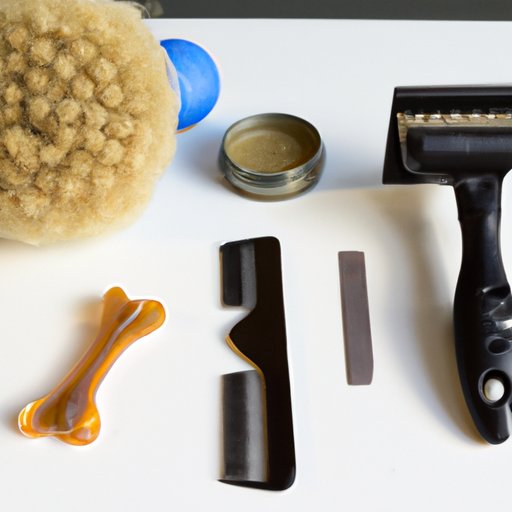Introduction
Dog shedding is a natural process in which dogs lose their old or damaged fur. It can range from light to heavy depending on different factors such as breed, age, and season. Fortunately, there are several ways to reduce the amount of shedding and keep your home clean.
Regular Brushing
Brushing your dog regularly is one of the best ways to reduce shedding. Not only does it help remove the dead fur, but it also helps distribute the natural oils in their coat, making it healthier and less likely to shed.
Benefits of Brushing
Regular brushing helps remove dirt and debris from your pet’s coat, preventing the accumulation of bacteria that can lead to skin problems. It also stimulates the production of natural oils, which helps keep their coat healthy and shiny. Finally, brushing can help identify any potential health issues early on, allowing for quick treatment.
Types of Brushes to Use
The type of brush you use will depend on your pet’s coat. For short-haired breeds, a rubber curry brush or a soft-bristled brush can be used. For longer-haired breeds, a metal comb or slicker brush is recommended. Be sure to use a brush specifically designed for pets, as human brushes can be too harsh on their skin.
How Often to Brush
Ideally, you should brush your dog at least once a week. If your pet has a long or thick coat, they may need to be brushed more often. When brushing, make sure to go against the grain of their fur to ensure all dirt and debris is removed.
Diet Adjustment
What your pet eats can have a significant impact on their coat and the amount of shedding. Adding certain foods to their diet can help reduce shedding and improve their overall health.
Benefits of Omega-3 Fatty Acids
Omega-3 fatty acids are essential for keeping your pet’s coat healthy and reducing shedding. They help keep their skin moisturized and prevent dryness, which can lead to excessive shedding. Omega-3 fatty acids also help reduce inflammation, which can help improve their overall health.
Best Sources of Omega-3 Fatty Acids
Good sources of omega-3 fatty acids include fish oil, flaxseed oil, and chia seeds. You can also find them in certain foods such as salmon, sardines, and tuna. Make sure to check the labels to ensure the product is free of contaminants.
How Much to Feed
When adding omega-3 fatty acids to your pet’s diet, it’s important to follow the instructions on the package. Depending on their size and weight, you may need to adjust the amount of food given. Talk to your vet if you’re unsure about how much to feed your pet.
Bathing
Bathing your pet regularly can help reduce shedding and keep their coat looking its best. However, it’s important to use the right products and not overdo it.
Benefits of Bathing
Regular baths help remove dirt and debris from your pet’s coat and can help prevent skin irritation and infections. Bathing also helps remove excess fur and dander, which can help reduce shedding.
Types of Shampoo to Use
When choosing a shampoo for your pet, make sure to pick one specifically designed for animals. Human shampoos can be too harsh on their skin and can cause irritation. Look for one that is hypoallergenic and free of harsh chemicals.
How Often to Bathe
How often you bathe your pet depends on the type of coat they have. Short-haired breeds may only need to be bathed every few months, while long-haired breeds may need to be bathed more frequently. Talk to your vet to determine the best schedule for your pet.
Grooming Tools
Using the right grooming tools can help reduce shedding and keep your pet’s coat looking its best.
Benefits of De-Shedding Tools and Undercoat Rakes
De-shedding tools and undercoat rakes are specially designed to loosen and remove dead hair and debris from your pet’s coat. They can help reduce shedding and keep your pet’s coat looking healthy and glossy.
What to Look for in a Grooming Tool
When choosing a de-shedding tool or undercoat rake, make sure to look for one that is designed for your pet’s coat type. Also, look for one with adjustable blades so you can adjust the length of the blades to suit your pet’s needs.
How to Use the Tool
When using the tool, start by brushing your pet’s coat to remove any tangles or knots. Then, use the tool to gently comb through their fur, starting at the base of the neck and moving down the back. Make sure to apply gentle pressure and avoid tugging or pulling on their fur.
Regular Vet Visits
Regular visits to the vet can help keep your pet healthy and reduce shedding.
Benefits of Up-to-Date Vaccinations and Checkups
Vaccinations help protect your pet from illnesses and diseases that can cause excessive shedding. Regular checkups can also help identify any potential health issues early on, allowing for quick treatment.
What to Look for in a Vet
When choosing a vet for your pet, make sure to find one who is experienced and knowledgeable about your pet’s breed. Ask for recommendations from friends or family, or search for reviews online.
How Often to Go
Your vet can help you determine how often your pet should be seen. Generally, puppies and kittens should be seen every 3-4 weeks, while adult dogs and cats should be seen every 6-12 months. Senior pets may need to be seen more frequently.
Conclusion
Dog shedding is a natural process, but there are several ways to reduce the amount of shedding and keep your home clean. Regular brushing, diet adjustment, bathing, grooming tools and regular vet visits can all help reduce shedding and keep your pet’s coat healthy and glossy.


